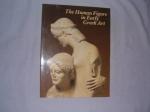|
This section contains 514 words (approx. 2 pages at 300 words per page) |

|
Ancient Greek Depiction of the Human Body
Summary: The depiction of the human body shifted throughout the Archaic, Classical, and Hellenistic periods of Ancient Greece.
The body is an important motif of Greek art. The Greek are famous for their many sculptures. Their depiction of the human body was not an immediate change to a set pattern. It evolved over the years. The depiction of the human body changed over the Archaic, Classical, and Hellenistic periods.
Archaic Greek sculpture is characterized by strict formulas for the depiction of the human body. The kouroi are good examples. The kouroi are so similar it is thought they may have been mass produced. Examples are the Kroisos from Anavysos and the Getty Kouros. The body is highly idealized. Almost all of the subjects are young, strong people. Movement is depicted by a slight step forward. Most human sculptures of the Archaic period display an "archaic smile." The "archaic smile" is a slight grin used to show that the subject was alive. The smile looks somewhat like...
|
This section contains 514 words (approx. 2 pages at 300 words per page) |

|


